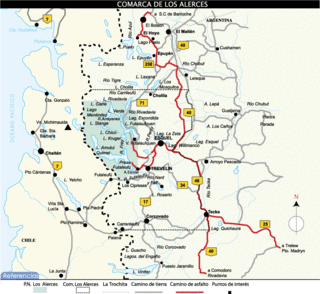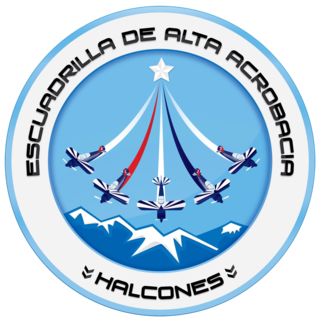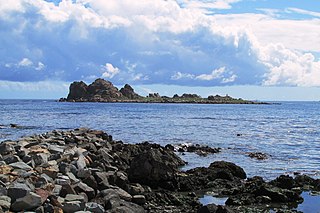
The Aconcagua River is a river in Chile that rises from the conflux of two minor tributary rivers at 1,430 metres (4,690 ft) above sea level in the Andes, Juncal River from the east and Blanco River from the south east. The Aconcagua river flows westward through the broad Aconcagua valley and enters the Pacific Ocean near the city of Concon, 20 kilometres (12 mi) north of Valparaíso.

Los Alerces National Park is located in the Andes in Chubut Province in the Patagonian region of Argentina. Its western boundary coincides with the Chilean border. Successive glaciations have molded the landscape in the region creating spectacular features such as moraines, glacial cirques and clear-water lakes. The vegetation is dominated by dense temperate forests, which give way to alpine meadows higher up under the rocky Andean peaks. A highly distinctive and emblematic feature is its alerce forest; the globally threatened alerce tree is the second longest living tree species in the world. The alerce forests in the park are in an excellent state of conservation. The property is vital for the protection of some of the last portions of continuous Patagonian Forest in an almost pristine state and is the habitat for a number of endemic and threatened species of flora and fauna.

Escuadrilla de Alta Acrobacia Halcones, known simply as the 'Hawks' (Halcones), is an active group of nine officers of the Chilean Air Force who are trained specifically for aerobatics. One of the Halcones' signature moves is recreating the Chilean star in the air using smoke. The team may be likened to the British Royal Air Force's Red Arrows for their affinity for complex, high-risk, aviation-based manoeuvers.

Nevado de Longaví is a volcano in the Andes of central Chile. The 3,242 m (10,636 ft) high volcano lies in the Linares Province, which is part of the Maule Region. It features a summit crater and several parasitic vents. The volcano is constructed principally from lava flows. Two collapses of the edifice have carved collapse scars into the volcano, one on the eastern slope known as Lomas Limpias and another on the southwestern slope known as Los Bueye. The volcano features a glacier and the Achibueno and Blanco rivers originate on the mountain.

Los Vilos? is both a Chilean coastal commune and a coastal city with over 9,000 inhabitants, located in the Province of Choapa, part of the IV Region of Coquimbo. The city has a harbour called Puerto Punta Chungo, that ships the material of Los Pelambres mine. Fishing is one of its main activities. The city also has a significant amount of tourism, mainly due to its two beaches: La Principal and Las Conchas. It is located at 246 kilometres (153 mi) from La Serena and 246 kilometres (153 mi) from Santiago.

Volcán Tupungatito is the northernmost historically active stratovolcano of the southern Andes. Part of the Chilean Andes' volcanic segment, it is the northernmost member of the Southern Volcanic Zone (SVZ), which is one of several distinct volcanic belts in the Andes. Over 70 Pleistocene or Holocene age volcanoes make up this volcanic belt, which on average has one eruption per year.

Los Flamencos National Reserve is a nature reserve located in the commune of San Pedro de Atacama, Antofagasta Region of northern Chile. The reserve covers a total area of 740 square kilometres (290 sq mi) in the Central Andean dry puna ecoregion and consists of seven separate sections.

Chacalluta International Airport is an airport serving the city of Arica, capital of the Arica Province in the northern Arica y Parinacota Region of Chile. It is 18.5 kilometres (11.5 mi) northwest of the city and 1 kilometre (0.62 mi) south of the border with Peru, adjacent to the village of Villa Frontera.
Balmaceda Airport is an airport next to the village of Balmaceda, serving the Aysén Region of Chile. The airport is 4 kilometres (2.5 mi) west of the Argentina border, it is located 55 km south-east of Coyhaique, the regional capital.

Diego Aracena International Airport is an airport serving Iquique, capital of the Tarapacá Region in Chile. The airport is on the Pacific coast 48 kilometres (30 mi) south of the city. It shares a runway with Los Cóndores Air Base, home to the First Air Brigade of the Chilean Air Force.

Chaitén is a volcanic caldera 3 kilometres (2 mi) in diameter, 17 kilometres (11 mi) west of the elongated ice-capped Michinmahuida volcano and 10 kilometres (6 mi) northeast of the town of Chaitén, near the Gulf of Corcovado in southern Chile. The most recent eruptive phase of the volcano erupted on 2008. Originally, radiocarbon dating of older tephra from the volcano suggested that its last previous eruption was in 7420 BC ± 75 years. However, recent studies have found that the volcano is more active than thought. According to the Global Volcanism Program, its last eruption was in 2011.
The Quilimarí River is a river of Chile. It arises from several small streams in the foothills of the Andes, and runs for some 50 kilometres (31 mi) westward to the mouth at Quilimarí on the Pacific coast.

Cáhuil is a Chilean village located 15 kilometres (9.3 mi) south of Pichilemu, at the mouth of the seasonal Nilahue Estuary, in the O'Higgins Region. Its economy is based on the production of sea salt, oysters, and mussels. The estuary is suitable for fishing, swimming, and boating.

The Corpus Christi Massacre or El Halconazo was a massacre of student demonstrators during the Mexican Dirty War in Mexico City on 10 June 1971, the day of the Corpus Christi festival. Nearly 120 protesters were killed, among them a 14-year-old boy.

The 2010 Pichilemu earthquakes, also known as the Libertador O'Higgins earthquakes, were a pair of intraplate earthquakes measuring 6.9 and 7.0 that struck Chile's O'Higgins Region on 11 March 2010 about 16 minutes apart. The earthquakes were centred 15 kilometres (9.3 mi) northwest of the city of Pichilemu.
San Rafael Airport Spanish: Aeródromo de San Rafael de Los Andes, is an airport serving Los Andes, a city in the Valparaíso Region of Chile. The airport is 5 kilometres (3.1 mi) west-northwest of the city.
Halcon or Halcones may refer to:

Pichilemu, originally known as Pichilemo, is a beach resort city and commune in central Chile, and capital of Cardenal Caro Province in the O'Higgins Region. The commune comprises an urban centre and twenty-two villages, including Ciruelos, Cáhuil, and Cardonal de Panilonco. It is located southwest of Santiago. Pichilemu had over 13,000 residents as of 2012.
TNT Sports Argentina is a subscription television channel mainly dedicated to the broadcast of the Argentine Primera División, along with ESPN Premium, which began broadcasting on Friday, August 25, 2017, from 6:00 p.m., after the alliance of Turner and Fox by the television rights of the Argentine First Division of Argentine soccer, being replacement of the governmental program Fútbol para Todos.

Club Halcones de Zapopan, formerly Club Deportivo Zap, is a Mexican professional football team based in Zapopan but plays in Zapotlanejo which originally played in the Liga de Balompié Mexicano, and in July 2021 was affiliated into Liga Premier de México – Serie A.















